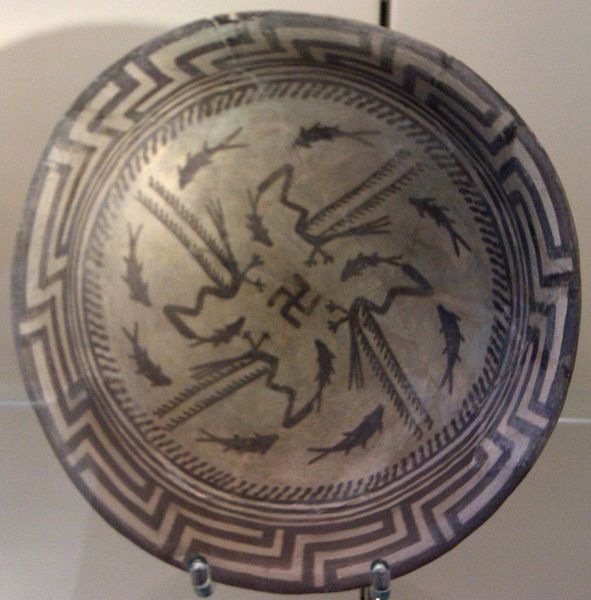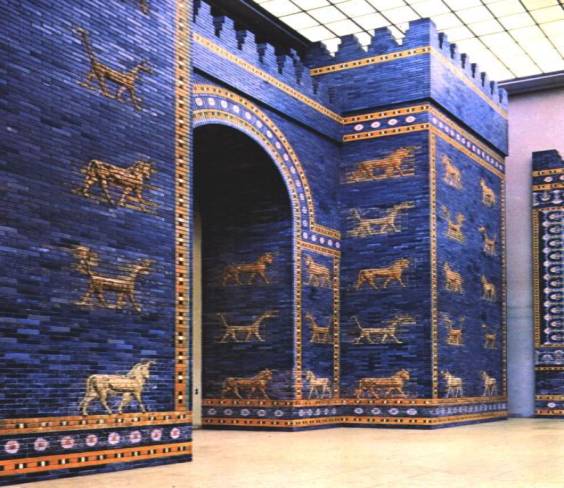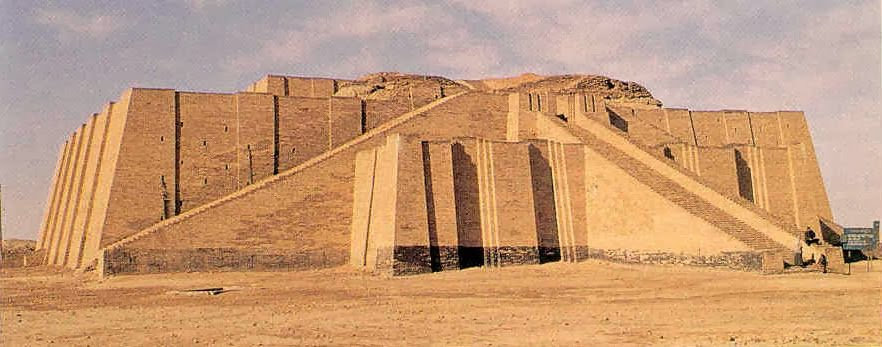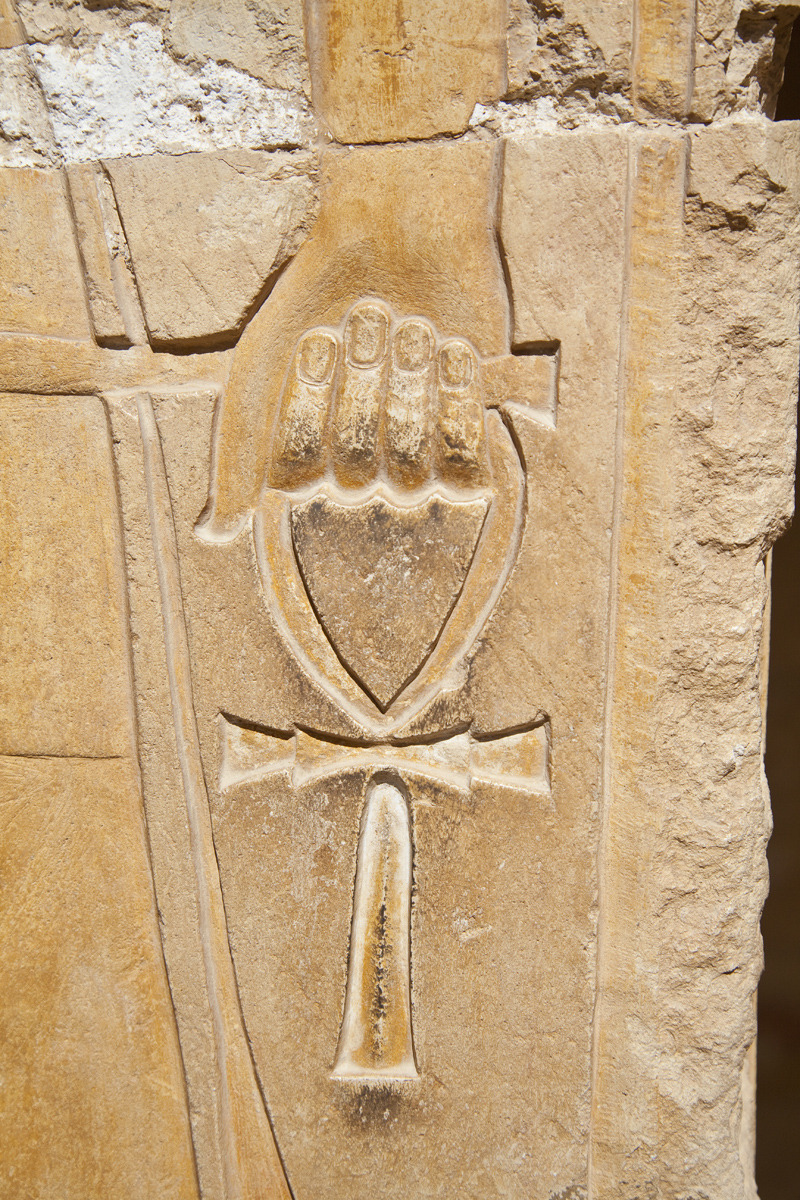The Oldest Symbols of Ancient Mankind
There are four symbols that stand out as the oldest symbols of man. These symbols have been with man from the very beginning. They were NOT venerated or worshiped as a religious iconic symbol, but had a significant meaning to many. The 1st was the Omega Sign, which originated in Sumeria. The second was the Swastika, which originated in Sumeria and the Indus River valley. The third symbol was the Egyptian Ankh symbol, which was the sole symbol of the Nile Valley. The fourth was the sign of the Crescent Moon and the star of Venus which appeared in Babylon.
The Omega
The Sumerian Omega symbol first appeared as a symbol for a medical device, because it's use in cutting the umbilical cord of a newborn child. This soon translated into a symbol for the meaning of life, or the beginning of life, or new life. An ancient God of Sumeria, also took the Omega as a symbol to represent herself. This was the fertility god, Ninhursag. The connection to fertility, to birth, to new life is then completed, as it was of the symbol of the birth opening.
The Sumerian Omega Symbol was often illustrated with curving lines,as in the illustration above, but latter this changed to the straight lines in the Greek Omega.
This Omega symbol was also used in connection with the Chariots of the Gods, as a means of illustrating that the flow of water from the chariot as indicated by wavy lines ending with the omega indicates a life force or a renewal of life. Seen below in this Sumerian relief, is water flowing downward from the chariot of the gods ending in an Omega, which the ancient Gods of Sumeria, have in their control. In between the gods is the tree of life. Is this relief portraying that the ancients were able to extend life, or give life with the use of the Omega symbol?
The wavy lines extending from the chariot to the omega is represented as water in Sumerian reliefs. Is it this water, that after being transformed after exiting the chariot, that is part of this extension of life?
This understanding would be that the Anunnaki were able to perpetuate life, or change into another life, with the use of an Omega like symbol, that was in some way directly linked or connected to these chariots, as in the Assyrian relief below depicts. Were these two men depicting the same man, though the one is much younger? Was this an effort to depict life could be extended and the Omega was a symbol of this extension.
An interesting account occurred in the city of Ur, just prior to it`s downfall. Sargon`s armies were moving south to surround Ur, after destroying many Sumerian cities, and butchering their inhabitants. The citizens of Ur were well aware of their outcome, so fear and panic must of been overrunning the city streets. A famous physician in the city, whose clay tablets still exist today was one of such inhabitants, and had much to fear. His name was Lulu, and he was well documented in text as being respected as a doctor.Lu in Sumerian means man. For whatever reasons, no one is able to determine, if he was able to escape Ur, prior to it`s downfall. Was he able to covertly use one of the Sons of Anu`s, Chariot`s of the Gods, and make his escape? He was trained in being observant, and to analysis, so after years of watching their use, did he finally steal one of the chariots and make his escape?
The Swastika
The sign of the Swastika goes back as early as 5000 BC as recorded by Sumerian pottery. The Swastika then disappears for a length of time before it reappears in the nation of the Hittites in Asia Minor, then it again disappears until it reemerges in the city of Troy. In each case with the emergence of the Swastika, a national state of emergency is evident. The people of these nations, and their culture were under military threat. Their very existence as a nation and as a people was under question, hence we see the rise of the Swastika, and nationalism. The Swastika seems to represent national pride and national unity. All three of these nations were completely destroyed by their enemies. In fact their devastation was so complete, that for many years, thousands of years, these civilizations were thought to not even exist. On the isle of Crete, the city state of Knossos, also venerated the Swastika. This was the famous society that had the labyrinth, and the creature with the bull's head, and the national symbol of the double headed axe. This city also was abandoned and disappeared around 1300 BC with no apparent reason.
Coins found at Knossos show a Swastika emblem, which was for them was a later symbol for the labyrinth, which they were to became famous for.

Sumerian pottery dating back to 5000 BC shows the sign of the Swastika.
My only advice from the following is if you live in a region that uses the Swastika with a lot of national fervor it's time to start packing. The Swastika is now appearing in Central Europe, which has many worried.
Henrich Schliemann, became famous with his digging to find the ancient city of Troy. From his digging emerged the Swastika. From that moment some evil emerged from that ancient pit. This symbol went on to be the national symbol for the German Nazi party, which we are all to familiar with., but like many points of history, not all is what it appears. Germany went from that point, to eventually being a nation in total ruin, very similar to the other nations that used the swastika, as their national emblem.
The story of Troy came from the stories that were sung or told as a orator tale by Homer. These tales were later written into two well known books. The tale revolves around the seduction of Helen by Paris of Troy who then takes Helen to Troy. Helen according to legend is considered the most beautiful woman in the world. This all makes for a great tale, and the premise of the tale, is why the tale has endured over the centuries. The real reason that these two mighty national groups fought, was not over a woman, but was over controlling the trade routes, from eastern Asia Minor and Asia itself, which all went through Troy. These ancient trade routes made Troy very wealthy. They were able to control the trade of goods entering the Aegean Sea, and from there to Greece.
Great nations and men fight over money and power, not women. This was true of the battle between the Achaeans and the Trojans, which lasted for over 10 years. A simple story about a war over a trade route would not of made much of a story.
The Swastika in the Indus Valley was used in the markings of doorways ( an eerie resemblance to Jewish doorways and the Torah) and the opening of account books, but it also stood for night and the Goddess Kali and magical practices. In Sumeria the Swastika also was associated with a God. Enki had a number of sons, but one son took the Swastika as his emblem. His name was Nazi
Nazi`s name and meaning can be translated by two different means, 1) its direct letter translation, and the other 2) by it`s meaning through context. The following is by context;
The Sumerian text dialogue between Enki and Ninhursag is as follows.
Ninhursag fixed Enki in her vulva
Brother what hurts you
My jaw ( tulla)hurts me
I have caused Nintulla to be born for you
Brother what hurts you
My tooth (suttu)hurts me
I have caused Ninsutu to be born for you
Brother what hurts you
My throat (Zi) hurts me
I have caused Nazi to be born for you
The text speaks of 8 children born and each child was given a gift or a reward. Nazi is given to Nindara in marriage. Whether this marriage is real or figurative is unclear, but it may help in understanding the clear meaning of Nazi, one of Enki's sons. First Na is often a prefix in Sumerian to denote a male personage. Nin is often used to denote a female.As an example Ninlil, Ninki, Ningal are all females while, names for males start with Na.
The text itself really determines the meaning of Nazi, (Zi) which means throat or voice. So Nazi has a gift for voice, and using his consort who could easily be the same God as in the Indus valley, Kali, a full name meaning for Nazi can be understood.
Nazi`s name may really mean Voice of Darkness, Prince of Darkness, or Prince of Dark Magic. Is this the Voice of Darkness that led Germany? A voice that was able to manipulate millions into terrible acts?
Crescent Moon and Star of Venus
Nannar, the first born son of Enlil, whose Akkadian name was "Sin", had the symbol of the crescent moon. He first appeared in the city of Ur, but later came to prominence during the time of Nabonidus the last King of Babylon. Nabonidus was the commander of the Babylonian army and was appointed as King from the ranks of his army. He was not an insider or from the Royal court of Babylon, nor was he approved by the religious clerics of Babylon. His first actions were to rebuild the temples of Sin throughout Babylon's empire, which brought him in direct opposition to the religious leaders, who were the absolute followers of God Marduk. Throughout his reign there was this continous resentment towards his reign and his Regent son because of this.
The Bible reports in Daniel, that Nebuchadnezzar was the king of Babylon, but this is not the truth. Is this because Daniel doesn't know who the king of Babylon is or can this be seen as a slight against Nabonidus, for his rebuilding the temples of Sin, instead of following the worship of Dagan/Ya?
Sin's temple in Babylon meant, "house of joy", and Sin was soon declared by Nabonidus as "Sin Supreme" and assumed the name Divine Crescent. In ancient Sumer the crescent moon was depicted with it's cusps straight up, which is not seen in the Northern Hemisphere, but in latitude 30, the location of Babylon, the moon can be seen this way. Almost as a saucer with the edges pointing up. This depiction of the moon can be seen below.

The Sumerian text records that Nabonidus had help to secure the throne of Babylon. The act of a Great God assisting man had not occurred in recent memory, as the text reads,
" This is the great miracle of Sin
That has not happened to the land
Since the days of old"
No man in memory had seen a great God with the use of a mighty weapon assisting in man's fate. Sin in Sumerian text assisted Nabonidus, to the throne, "using the weapon of Anu", and for this, the temples of Sin were rebuilt.
The other notable god in Babylon was Sin's daughter, Inanna or her Akkadian name Ishtar. The great blue gate of Ishtar, from the ruins of Babylon can be seen in Pergamon Museum Berlin.

Ishtar's symbol was the planet Venus, which was represented by a star. Venus is the second brightest object in the night sky behind the moon, so Ishtar held an important position in the realm of gods. Ishtar was extremely ambitious and often used her famine ways to determine an outcome.
Babylon was one of the very few city states that was NOT destroyed when an invading army captured it. With rare exception, after a city is captured by an invading army it is completely sacked, and burnt to the ground. This again is in contrast to the Bible's story. Nabonidus power came to an end, because the Royal families and the religious clerics of the city secretly made a treaty with Cyrus of Persia. The city was turned over to Cyrus, under the condition that their old religion would be restored. Babylon fell with not even a brick overturned, and the King of Babylon was sent to a distant land (Eastern Persia) to administer.
Dagan/Ya wanted the Semitic people to worship him not his long standing adversary Enlil and his offspring, Sin and Ishtar.The same old battle fought over and over again.
In our modern world of today the Crescent moon and the star of Venus can still be seen. Throughout the middle east these two symbols are still highly venerated. Just look at the flags throughout the region.
The flag of Turkey is an example of the crescent moon of Sin and the star of Ishtar.
The ancient people of Elam also show their honour to the crescent moon and star as indicated on their coins.
So who was Nabonidus? His mother is known. She was the priestess of the Moon God, Sin in the city of Harran, but nothing is known of his father except the script text that list his father "from important origins". His family lineage is not of the previous Kings of Babylon who were Chaldean's, who he overthrew to ascend the throne. The young King Labashi-Marduk was quickly displaced allowing Nabonidus to become King. Many accounts of his kingship seem difficult to understand but he lived for many years in the city of Tayma, and that part of his life mostly goes unaccounted for. One interest in his life seems to dominate his kingship and that is his interest in Babylon's past and the regions many Gods.
In his reign he decreed that all statues of the Gods of the Mesopotamia valley would be moved to his capital of Babylon. This brought much distrust and hatred against his rule. He also reestablished Sin as the main God of Babylon and he restored Sin's many temples, including the temple at Harran, and the Ziggurat at UR.

The Ziggurat of Ur, which was built and dedicated to Sin, by the early Sumerians, was restored by King Nabonidus. The text of Nabonidus reads; "finding little left, but the first stage, and nothing to guide him, as to the monuments original appearance". Nabonidus restored the Ziggurat to it's early structure of 7 steps.
The question still is who was Nabonidus and who was his father? Again similar to Sargon, Nabonidus was the son of a Great God, but unlike Sargon's father Dagan, Nabonidus father was Sin. Nabonidus was probably the last great Nefilim, and Sin's seed was in conflict with Dagan's seed.
The Sons of Annu used this same method to control the rule of Mankind over and over again. The use of the same M.O. same plot, same plan, and same outcome. Sargon, Moses and Nabonidus all have similar life stories. Simply put the seed of a Great God in a great position of power, and then rule mankind. Was this "Modus Operandi" used again to destroy the Jewish peoples, Dagan's seed, in the Second World War?
For further reading; Blog: The Nephilim
The next question and by far the most intriguing: Is Nabonidus still alive? We know that the Nefilim live a very long time, so is it possible that he still live? Would he be in a position of power and wealthy? Would he be a silent and unknown, almost arms length from the real seat of power? Hidden from the view of the public. So if he does exist then who would he be?
The Ankh
The Egyptian ankh was a symbol of life, or eternal life, and has recently become the national symbol of modern day Egypt in their efforts to expand their tourist trade. The Ankh is also said to mean the Key of life, or the Key of the Nile, as it is often depicted by Egyptians Kings as if they are holding the Ankh as a key. Note the illustration below.

The origins of the Ankh go back to the very beginning of Egypt, and how the design is implicated into the meaning of life is unknown. The general feature of the symbol does seem to reflect the image of Isis as seen below. Isis means "throne" which is often depicted as part of her headdress. The King of Egypt was also often shown in a relief beside her as a small child. That would indicate that she was a protector of the King, and his power.

The Coptic Christians soon took the Ankh to represent the Christian cross, but this wasn't it's original purpose.
If you you observe the Ankh from another perspective, it looks very much like the ancient Shen, or the Omega symbols. They all have one underlying similarity. The representation of "Life".
For further reading;
http://trueancienthistory.blogspot.ca/2013/04/the-search-for-lost-arch-of-covenant.html




thank you this is amazing i can feel being there i can see
ReplyDeleteThank you for your comment
ReplyDeleteThis is amazing brother , you should have a reference table ...no?
ReplyDeleteThis comment has been removed by a blog administrator.
ReplyDeleteThis blog post provides fascinating insights into ancient symbols.
ReplyDeleteThank-you for your comment
Delete